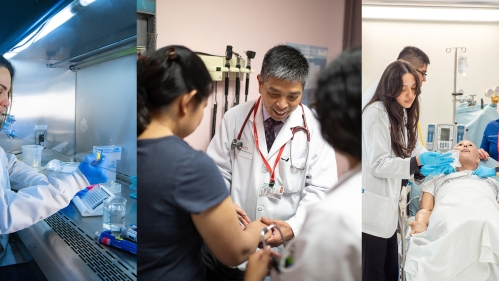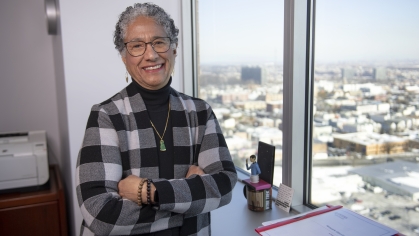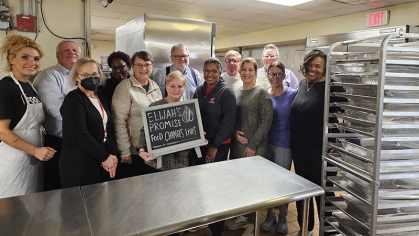A Rutgers Biomedical Research Powerhouse Turns 10

On Aug. 22, 2012, then-Gov. Chris Christie made a bold prediction about New Jersey’s flagship university.
“Rutgers was already an outstanding institution,” the governor said as he signed into law the New Jersey Medical and Health Science Education Restructuring Act. “Now, it’s going to be a powerhouse.”
This month marks 10 years since the creation of Rutgers Biomedical and Health Sciences (RBHS), born from legislation introduced by then-Senate President Steve Sweeney and Senators Donald Norcross and Joseph F. Vitale and championed by Christie. Designed to strengthen collaboration opportunities and draw more research funding to the state, the education bill transferred to Rutgers most of the assets of the University of Medicine and Dentistry of New Jersey (UMDNJ) – including the medical schools in Newark and New Brunswick.
Nine UMDNJ schools and institutes were legally integrated into Rutgers on July 1, 2013. It was the largest higher education merger in United States history.
Integrating UMDNJ’s schools with Rutgers was a feat of administrative perseverance. Overnight, Rutgers grew by approximately 6,500 students, 10,000 faculty and staff, and 6.2 million square feet of buildings and land. To ensure a smooth transition, UMDNJ and Rutgers staff worked for a year after the legislation was signed to ensure no interruptions to student learning, patient care, student financial aid, housing allowances, staff pay and more.
“Bringing UMDNJ and Rutgers together is the accomplishment I am most proud of during my time at this university,” said Christopher J. Molloy, the former dean of the Rutgers Ernest Mario School of Pharmacy who oversaw the integration of the two schools. “It was a very heavy lift, with many challenges. But the results speak for themselves.”
One decade later, the outcome has exceeded even the most optimistic expectations. “Rutgers is much stronger because of the integration,” said Denise V. Rodgers, vice chancellor of interprofessional programs at RBHS and the final president of UMDNJ. “There have been some very important programs developed and others strengthened by building upon the natural synergies that existed in the two institutions.”
Rodgers added: “I grew up in Michigan, where there is huge pride in our state universities. I want Rutgers to be like that for New Jersey. Rutgers is an outstanding university that should be fully embraced by the people it serves.”
“My goal since arriving at RBHS has been to build one of the best academic health centers in the country, with an emphasis on one,” said RBHS Chancellor Brian L. Strom. “We’re succeeding, and the integration with UMDNJ made it possible.”
Rutgers is today among the nation’s top public institutions. In 2012, the university was ranked No. 25 on U.S. News and World Report’s list of public U.S. colleges. Today, Rutgers-New Brunswick is No. 19, tied with the University of Maryland and Florida State.
As Rutgers has climbed in the rankings, students have taken notice: This year, the Robert Wood Johnson Medical School received 5,800 applications, an 83 percent increase from 2012. The New Jersey Medical School received 5,880 applications in 2023, a 70 percent jump from 2012.
New research support also has found its way to Rutgers. Today, research expenditures top $730 million annually – putting Rutgers among the largest research entities in the U.S. During the last decade, RBHS has brought into Rutgers $3.6 billion in new extramural awards.
These efforts have had a direct impact on the state’s economy, said Debbie Hart, president and chief executive of BioNJ, a life-sciences trade association representing the biopharmaceutical and biotechnology industry in New Jersey.
“This was, in many ways, the answer to a very specific need in the state’s life sciences ecosystem – the need for increased medical innovation and the benefits that come with it for students, patients, and the economy,” said Hart. “The integration of UMDNJ and Rutgers has delivered, and continues to deliver, significant and meaningful economic results for New Jersey and beyond.”
A crowning achievement was the award in 2019 of a $29 million Clinical and Translational Science Award from the National Institutes of Health to help translate clinical research into patient care and treatments. Rutgers’ contribution to understanding and ending the COVID-19 pandemic also is a matter of immense pride for Strom and others.
To be sure, work remains. The ongoing partnership between Rutgers Health and RWJBarnabas Health will build one of the most comprehensive academic health systems in the state. Construction of a new biomedical sciences building in downtown New Brunswick will house RWJMS and Rutgers translational research programs to facilitate the spinout of new medicines and treatments.
These and other plans will help ensure that Rutgers remains an institution of, and for, all of New Jersey.
RBHS 10th Anniversary
In 10 years, Rutgers Biomedical and Health Sciences (RBHS) has seen transformational achievements that have catalyzed us, changed Rutgers, and benefitted New Jersey and our valued partners and communities.



